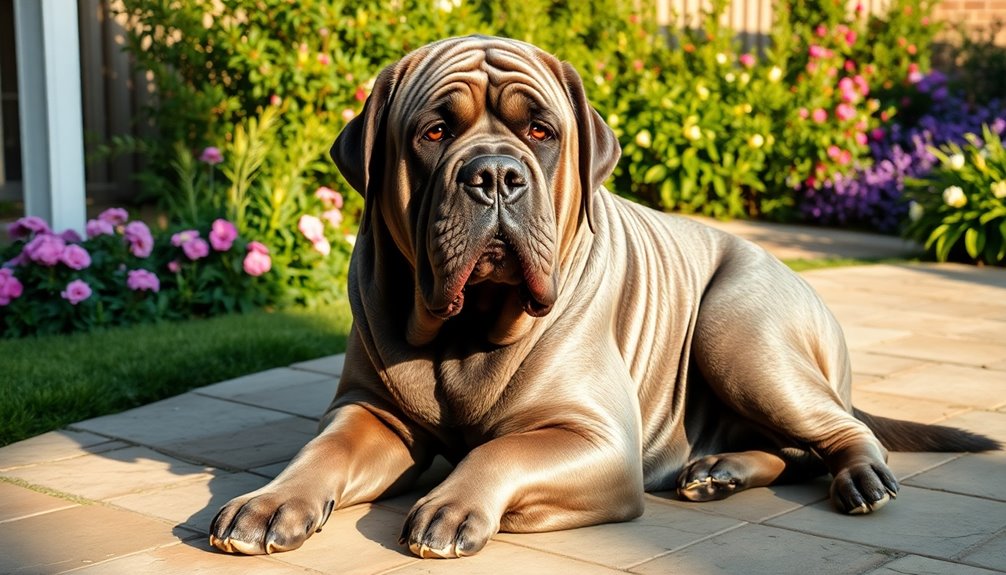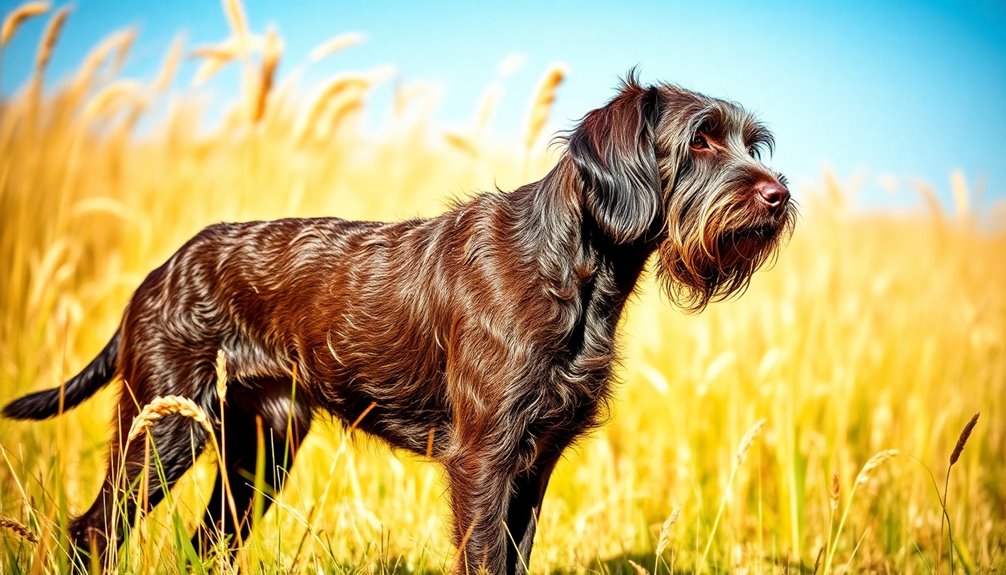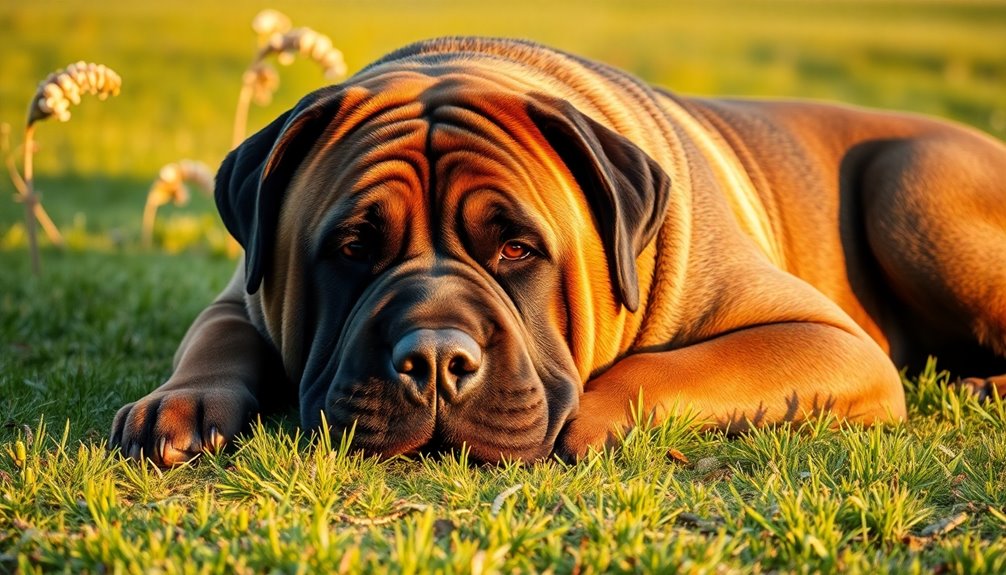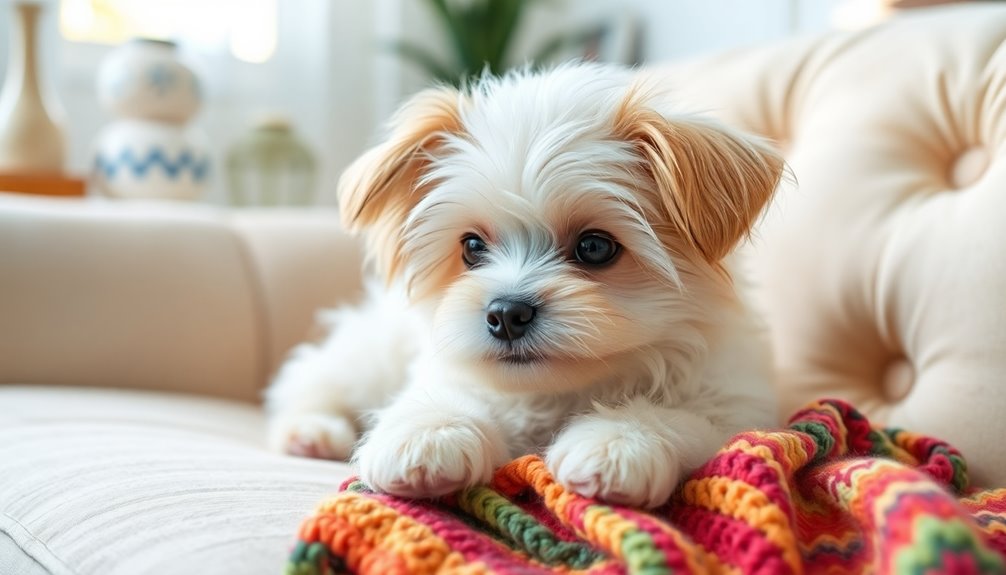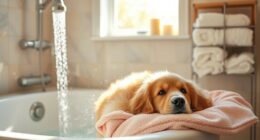The Neapolitan Mastiff is an impressive breed that combines ancient guardian instincts with an affectionate personality. Standing tall and robust, these dogs have a unique look with their loose skin and deep-set wrinkles. Despite their intimidating size, they're gentle and loving towards families, especially older children. Their history as protectors of estates speaks to their vigilance and loyalty. However, it's essential to provide consistent training and socialization to bring out their best nature. With proper care and attention to their health needs, you'll discover just how deeply they can bond with you and your family.
Key Takeaways
- Neapolitan Mastiffs are ancient guardians, originally bred to protect estates and livestock from predators and intruders.
- Their gentle temperament makes them affectionate and loyal family companions, especially with older children.
- Regular grooming and health check-ups are essential to maintain their unique appearance and address potential health issues.
- They require a spacious living environment and daily exercise to ensure their physical and mental well-being.
- Early socialization and consistent training help manage their territorial nature and foster harmonious relationships with other pets.
Introduction
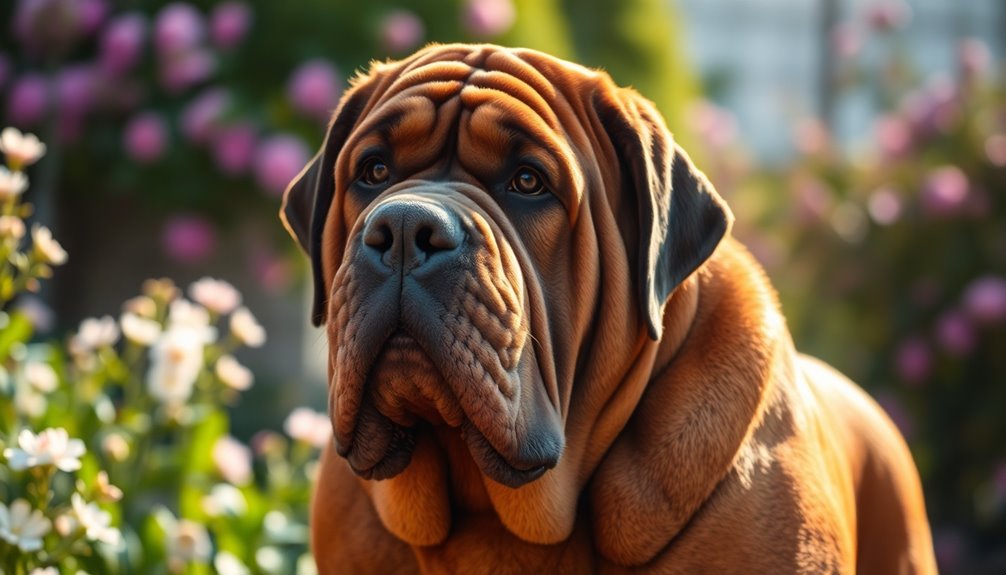
Introducing the Neapolitan Mastiff, you'll find a breed steeped in history and known for its impressive stature. These gentle giants stand between 24 to 31 inches tall, with males weighing as much as 200 pounds. Their stocky, heavy-boned bodies exhibit loose skin and distinctive wrinkles that give them a unique appearance.
You'll notice their short, smooth coat comes in various colors, including black, blue, mahogany, tawny, and brindle markings, complementing their large dewlap and long, floppy jowls. Additionally, their abundance of facial wrinkles is a hallmark of the breed, contributing to their distinctive look.
Despite their formidable size, Neapolitan Mastiffs are loyal and protective, making them excellent guardians of your home. They're affectionate and gentle with family members, but you might find them a bit stubborn or independent at times. It's essential to socialize them early to ensure they're comfortable around strangers and other pets.
Although they've low energy levels, requiring only daily walks, their health can be a concern. Be aware that they can face issues like cherry eye, hip dysplasia, and bloat.
Proper care, including regular grooming, will keep your Neapolitan Mastiff healthy and happy, ensuring you both enjoy a long, loving companionship.
History and Origin
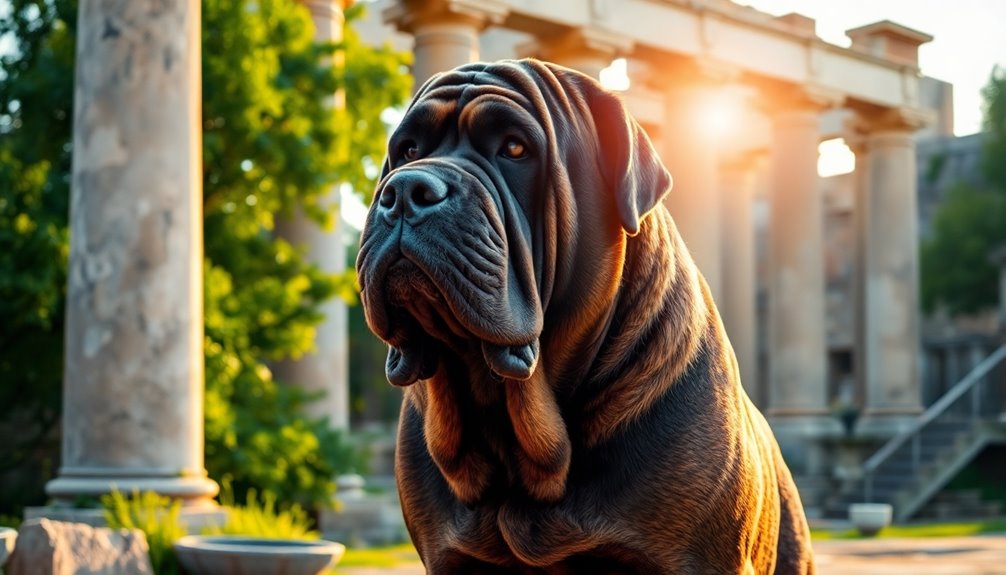
The Neapolitan Mastiff boasts a rich history that dates back to ancient times, tracing its roots to the Molossus war dog. Originating in regions like Greece, and possibly Tibet or Egypt, these dogs were bred to guard estates and livestock. Over the centuries, their formidable presence made them invaluable protectors for homes and property. The breed selection for the Neapolitan Mastiff was officially initiated in 1947 by Piero Scanziani, further establishing their reputation as dedicated guardians.
Where and when the breed originated
With roots tracing back to 3000 B.C., the Neapolitan Mastiff is steeped in a history that spans multiple ancient civilizations. This breed's ancestry connects to the giant war dogs of Egypt, Persia, Mesopotamia, and Asia. You'll find their likeness captured in ancient art and bas-reliefs, illustrating their roles in combat and hunting. The Neapolitan Mastiff is a direct descendant of the formidable Molossus war dog, known for its strength and loyalty.
Around 330 B.C., Alexander the Great crossed these giant war dogs from Macedonia with shorthaired dogs from India, further shaping the Molossus. This breed, noted for its wide, short muzzle and heavy dewlap, became essential in battle and gladiatorial arenas.
The Romans later adopted the Molossus for their combat and hunting needs, enhancing its size and presence through selective breeding. Protective and loyal, these dogs were favored not just for their strength but also for their ability to bond with families.
In southern Italy, particularly near Naples, the breed evolved into the Neapolitan Mastiff, blending protective instincts with a loving nature. Over centuries, Italian breeders refined these dogs, ultimately recognizing their value as both guardians and companions, especially after World War II.
Guarding Estates and Livestock
How did the Neapolitan Mastiff evolve into such a formidable guardian of estates and livestock? This breed hails from Naples, Italy, where it was historically tasked with protecting properties and homes.
As a farm dog, the Neapolitan Mastiff kept a vigilant watch over herds of cattle and goats, safeguarding them from predators like wolves. Its impressive size and intimidating presence were key in deterring intruders, making it a reliable guardian during nighttime. The breed's origins as ancient war dogs contributed to its natural guarding instincts. Many of the architectural features of properties guarded by these dogs reflect historical preservation efforts.
Bred for its protective instincts, the Neapolitan Mastiff developed strong aggression towards outsiders while forming deep bonds with family and livestock. With its heavy loose skin and dewlap, this breed could intimidate any potential threat.
Selective breeding emphasized docility towards loved ones, ensuring the Mastiff could defend its territory fiercely yet affectionately.
In modern times, you'll find these dogs still excelling as estate guardians and family protectors. Their loyalty and natural guarding capabilities make them invaluable.
However, proper socialization is crucial, as it helps prevent overly aggressive behaviors. Overall, the Neapolitan Mastiff remains a steadfast protector, combining strength with a loving heart.
Physical Characteristics
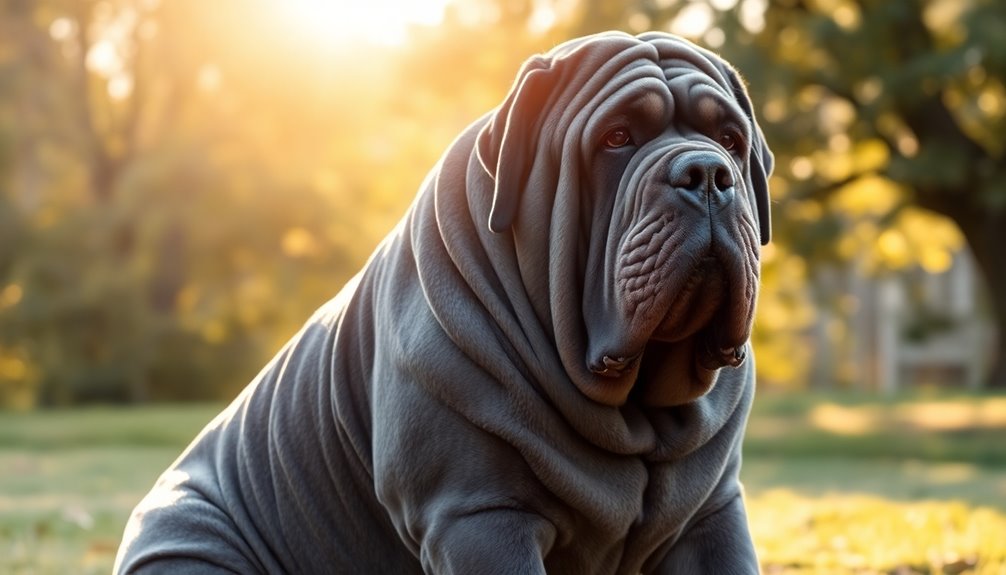
When you look at a Neapolitan Mastiff, you can't help but notice its impressive size and weight, ranging from 110 to 153 pounds.
The breed's short, smooth coat comes in various colors, including black, blue, and tawny, adding to its striking appearance.
You'll also see the distinctive prominent facial wrinkles that give this ancient guardian its unique character. Additionally, these dogs have a powerful size and a lumbering walk that further enhances their imposing presence.
Size, weight, and coat details
The Neapolitan Mastiff stands out with its impressive size and distinctive physical traits. As you observe this breed, you'll notice males typically stand between 26 to 31 inches at the withers, while females range from 24 to 29 inches. Their overall body length can reach 37 to 45 inches, making them a striking presence.
In terms of weight, you can expect males to average around 150 pounds, while females usually weigh about 110 pounds. However, some individuals may be heavier, depending on their size and massiveness. The breed favors a greater weight, as long as they maintain proper proportions.
When it comes to their coat, the Neapolitan Mastiff boasts a short, dense covering. The hairs are straight and no longer than one inch, offering a uniform length and smoothness across their body. Preferred colors include black, gray, and leaden, though mahogany and fawn are also acceptable.
You might notice some brindling or minor white markings on their toes and chest, but solid white is restricted to specific areas. This combination of size, weight, and coat details contributes to the Neapolitan Mastiff's imposing yet loving demeanor. Additionally, the breed's impressive average lifespan of 7 to 10 years emphasizes the importance of regular health screenings for their well-being.
Prominent Facial Wrinkles
Prominent facial wrinkles give the Neapolitan Mastiff its unique and expressive appearance. These abundant wrinkles and folds on the face, muzzle, and nose are essential for the breed's characteristic expression, combining a gentle and intimidating look. The loose skin, especially the hanging folds on the face, enhances their distinctive guard dog appearance.
You'll notice the deep-set eyes, often nearly hidden beneath drooping upper lids. The lower lids may droop enough to reveal the haw, though this isn't ideal per breed standards. The wrinkles accentuate the flat forehead and create pronounced furrows when the dog is alert, making their expressions particularly striking. Additionally, the breed's selective breeding has contributed to their impressive physical traits, further solidifying their role as protectors.
However, these wrinkles come with responsibilities. Regular cleaning of the face, lips, eyes, and ears is crucial to prevent skin infections or sores. Moisture trapped in the folds can lead to issues if not maintained properly.
The Neapolitan Mastiff is prone to health concerns partly due to these physical characteristics, including the common cherry eye condition affecting the third eyelid.
Temperament and Personality
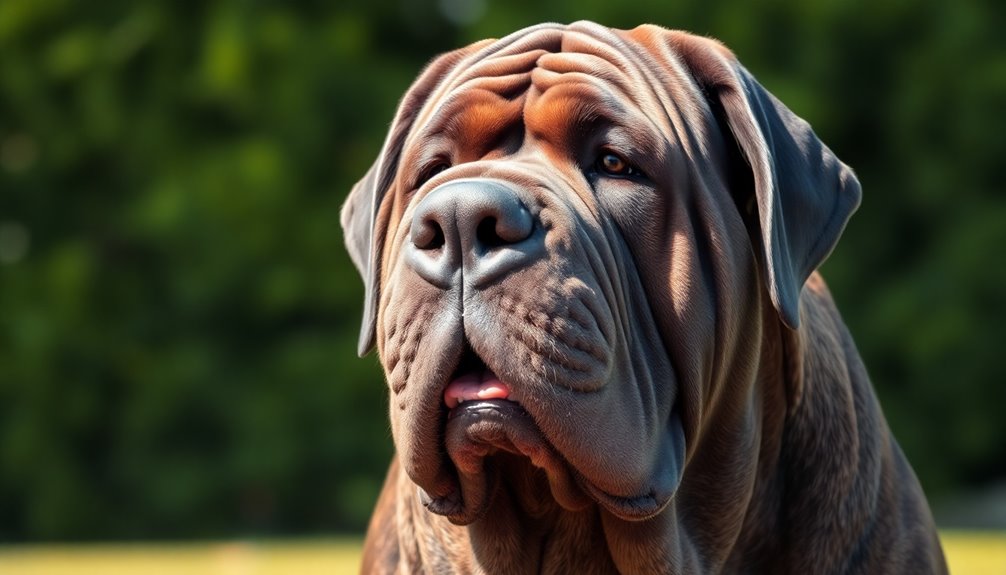
When you think about the Neapolitan Mastiff, picture a dog that's both protective and gentle, making them perfect for families and individuals alike.
Their calm demeanor and loving nature allow them to bond well with children and even other pets, provided they're socialized from an early age. This breed's energy level is generally low, which means they require minimal physical activity, making them suitable for a variety of living situations.
While they can be wary of strangers, their strong guardian instincts ensure that your home feels secure.
Protective yet Gentle Nature
With their imposing size and protective instincts, Neapolitan Mastiffs make excellent guardians for families and homes. These gentle giants are deeply loyal and affectionate, often forming strong bonds with family members. Their natural wariness of strangers means they'll protect your home fearlessly, acting decisively against perceived threats.
However, this protective nature requires early socialization to ensure they're comfortable around new people and other dogs. Without proper exposure, they can display aggression toward unfamiliar dogs.
Despite their strong guarding instincts, Neapolitan Mastiffs are calm and steady companions, preferring to follow you around the house rather than being left alone. Their affectionate demeanor leads them to enjoy family interactions, showcasing their loving hearts. Additionally, their average weight of 110-150 lbs highlights their massive build, which can be both intimidating and comforting.
However, they do have independent streaks and can be stubborn, so consistent training is vital. Remember, while they may be slow to respond to commands, it's not due to a lack of intelligence; they simply need clear boundaries and patient guidance.
Regular interaction is essential for these dogs to thrive; otherwise, they may experience anxiety or boredom. With the right approach, you'll find that Neapolitan Mastiffs are both protective and gentle, making them exceptional family companions.
Suitability for families, individuals, or other pets
Neapolitan Mastiffs can be a great fit for families and individuals, but their suitability largely depends on your household dynamics. If you have young children, be cautious; their size and strength can unintentionally cause harm. They're better suited for families with older kids who can understand how to interact safely. You'll need to provide strong leadership and consistent training, especially during playtime, to prevent accidents.
For individuals, these dogs thrive in low-activity environments. They enjoy being close to their owners and need regular interaction to avoid anxiety. Neapolitan Mastiffs are known for their highly territorial nature, making them instinctively protective of their family and territory.
While they can be affectionate, they often bond with a single family member, so consider how that fits into your lifestyle. When it comes to other pets, Neapolitan Mastiffs generally get along well if raised together from a young age. However, early socialization is crucial to prevent dominance and territorial behavior.
Keep in mind they can be aggressive towards other dogs, especially of the same sex, and may chase cats. With patient, reinforcement-based training, you can help manage their interactions with other pets, ensuring a harmonious home.
Health and Lifespan
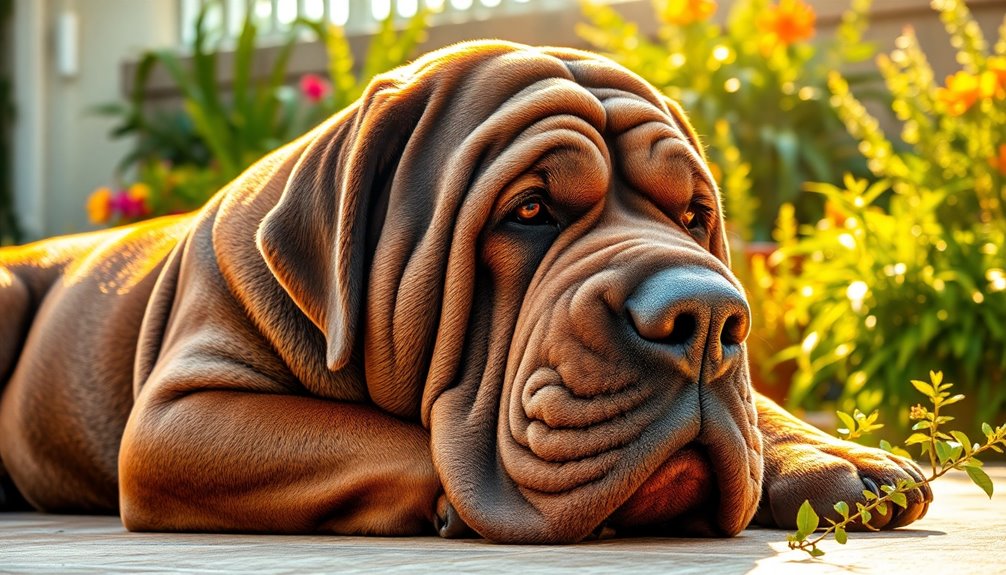
When you own a Neapolitan Mastiff, it's crucial to understand their typical lifespan of 7-9 years and the common health issues they face, like heart conditions and orthopedic problems. To help your furry friend live a longer, healthier life, regular check-ups and a balanced diet are key. Staying proactive about their health can make a significant difference in their well-being, especially considering their genetic predispositions to various health risks.
Typical lifespan of the breed
The typical lifespan of a Neapolitan Mastiff ranges from 8 to 10 years, which is notably shorter than many other breeds. A 2024 UK study even found an average life expectancy of 9.3 years for this majestic giant. While females generally live longer than males, individual lifespans can vary based on several factors.
Nutrition plays a critical role, so providing a balanced diet is essential for your dog's longevity and health. Their size contributes to a shorter lifespan, as larger dogs often face increased stress on their joints and organs. Genetics can also play a significant role in determining health issues that may affect lifespan.
To enhance their well-being, ensure they live in clean, safe, and spacious conditions. Regular veterinary care, including vaccinations and preventative measures, is vital.
You can also impact your Mastiff's lifespan through lifestyle choices. Ensure your dog gets adequate exercise, especially when young, and provide enough space for movement.
Prioritize health over appearance when considering breeders, as responsible breeding can lead to a longer life. Overall, while the Neapolitan Mastiff's lifespan is shorter compared to other breeds, proper care and management can significantly extend their time with you.
Common health concerns or genetic predispositions
Common health concerns and genetic predispositions can significantly impact the well-being of your Neapolitan Mastiff. One of the most prevalent issues is hip dysplasia, which leads to arthritis and mobility problems. Elbow dysplasia can also cause pain and limit movement. Both conditions are common in large breeds like yours.
Gastric torsion, or bloat, is another serious concern that requires immediate veterinary attention. Additionally, obesity can exacerbate joint issues and other health problems.
Eye-related issues are common too. Conditions like Progressive Retinal Atrophy (PRA) can lead to blindness, while ectropion and entropion may expose your dog's eyes to irritants. Older Mastiffs often face cataracts, which can be surgically corrected.
Heart health is critical as well. Dilated cardiomyopathy (DCM) is a life-threatening condition that weakens the heart. Regular ECG and echocardiogram screenings are essential from age one. Regular veterinary check-ups are also recommended to monitor health, as early detection can lead to better outcomes.
Lastly, your Mastiff may be at risk for cancer and autoimmune thyroiditis, along with skin allergies due to their unique skin folds. Regular check-ups can help catch these issues early, ensuring your beloved guardian remains healthy and vibrant.
Tips for maintaining health and wellness
Maintaining your Neapolitan Mastiff's health and wellness is essential for a long and vibrant life. Start by tailoring their diet to their age, ensuring you use a balanced commercial dog food or a well-prepared home diet. Avoid over-supplementing with calcium, which can lead to orthopedic issues. Understanding the importance of long-term financial planning for veterinary care can also alleviate stress when unexpected health issues arise.
Be mindful of proper feeding amounts to prevent obesity, which can strain their organs and joints.
Establish a tailored exercise routine that matches your dog's energy level—moderate exercise, like short walks or play sessions, is key. Make sure they've enough space to move around, especially when they're young, and avoid overexertion, particularly in warm weather. Regular check-ups with a vet are vital for monitoring overall health.
Regular veterinary check-ups are crucial. They help monitor overall health, ensure vaccinations are up-to-date, and allow for early detection of any potential issues. Your vet can provide guidance on nutrition and exercise tailored to your dog's needs.
Lastly, create a clean, safe living environment with constant access to fresh water, and prioritize regular grooming to maintain hygiene, especially in skin folds.
Care Requirements
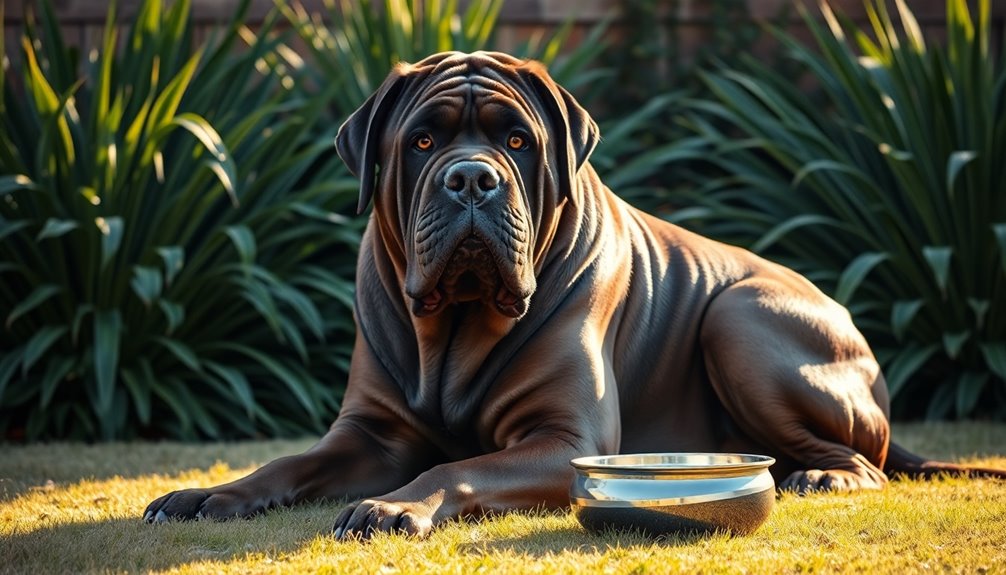
Caring for your Neapolitan Mastiff involves understanding their unique exercise needs, grooming routines, and dietary requirements.
You'll find that they require minimal grooming but do need regular exercise to stay healthy and happy.
Feeding them a balanced diet is crucial, so let's explore the best practices to keep your pup thriving. A tailored diet is essential for their overall health, emphasizing the importance of high-quality food for well-being.
Minimal Grooming Required
Grooming a Neapolitan Mastiff is relatively straightforward, making it a great option for those seeking a low-maintenance dog. Their short, dense, and smooth coat doesn't require daily brushing; you can simply brush them once a week with a rubber curry brush or grooming mitt. This helps remove loose hair and distributes natural skin oils, keeping their coat healthy. Bathing every 2-3 months or as needed will maintain cleanliness.
Pay special attention to their loose, wrinkled skin, particularly around the face and neck. Use a damp, soft cloth or baby wipes to clean the wrinkles and make sure to dry them thoroughly afterward to avoid moisture buildup. Applying a skin-safe, fragrance-free moisturizer can also help prevent irritation. Thorough drying is crucial, especially in skin folds, to prevent unpleasant odors and maintain skin health.
Regular ear and eye inspections are important too. Clean the ears with a soft cloth or dog-specific ear cleaner, but avoid inserting anything into the ear canal. For the eyes, check for discomfort or discharge and clean the area as needed.
Lastly, don't forget about nail trimming and dental care. Trim their nails every few weeks and brush their teeth regularly to keep their oral health in check.
Exercise requirements and energy levels
For a Neapolitan Mastiff, daily exercise is essential to keep them healthy and happy. You'll want to aim for at least two walks each day—one in the morning and another in the evening. Tailor the length and pace of these walks to your dog's age, health, and energy level.
Mature Mastiffs typically need about an hour of exercise daily, broken into smaller sessions, while young puppies only require about five minutes of exercise per month of age, up to twice a day. Neapolitan Mastiffs are known for their clumsiness as puppies; therefore, it's important to ensure that their exercise routine is safe and suitable for their developing bodies.
Moderate activities like short play sessions or swimming are excellent low-impact options that avoid stressing their joints. Games like fetch and hide-and-seek can also keep them engaged. Always choose softer surfaces like sand or grass for playtime.
Mental stimulation is just as important as physical exercise. Interactive toys, puzzle feeders, and basic obedience training can keep their minds sharp, helping prevent boredom and destructive behavior.
Remember, Neapolitan Mastiffs are sensitive to extreme temperatures, so adjust their exercise routine accordingly. Regular veterinary check-ups are crucial to monitor their health and adapt their exercise plans as needed.
Supervise playtime to ensure safety due to their large size and strength.
Feeding tips and diet recommendations
Maintaining a well-balanced diet is key to ensuring your Neapolitan Mastiff remains healthy and thrives. Focus on high-quality animal proteins like chicken, beef, or fish to support muscle development. Healthy fats, particularly omega-3 and omega-6 fatty acids, are essential for a shiny coat and cognitive function. Incorporate digestible carbohydrates, such as brown rice or sweet potatoes, but keep portions limited to prevent obesity. A species-appropriate diet that includes natural vitamins and minerals from meat and plant sources further enhances their overall well-being.
For feeding schedules, puppies should eat 3-4 times daily until six months, then transition to three meals. Once your dog is an adult, aim for two meals a day using food formulated for large breeds. Senior dogs need fewer calories but should receive high-quality proteins to sustain muscle mass.
Avoid free-feeding to prevent overeating, and consult your vet to determine appropriate portion sizes based on your dog's weight and activity level. To prevent health issues, maintain a lean body weight, choose low-sodium options for heart health, and avoid exercising your dog immediately after meals to reduce the risk of bloat.
When selecting food, ensure high-quality animal protein is the first ingredient and consult your veterinarian for tailored dietary recommendations.
Training and Socialization
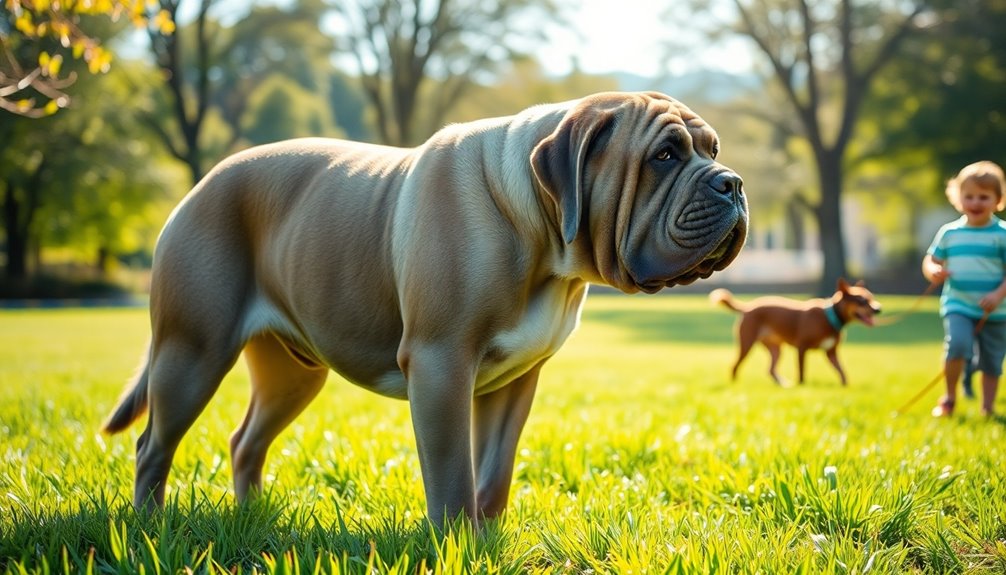
When training your Neapolitan Mastiff, you'll notice their moderate intelligence can be paired with a stubborn streak. To tackle this, introduce them gradually to new friends and experiences, making each interaction positive. Be mindful of leash reactivity with strangers, as consistent training and socialization will help them feel more at ease. Early socialization is critical for behavior development and can significantly reduce potential behavioral issues.
Moderate Intelligence and Stubbornness
Training a Neapolitan Mastiff can be both rewarding and challenging due to their moderate intelligence and occasional stubbornness. While they're intelligent, they often learn at a slower pace and may require a bit more patience from you. Positive reinforcement is key; they respond well when rewarded for good behavior. Starting training early is crucial to curb stubbornness and instill good habits.
Establishing consistent, firm, and fair leadership is essential. Without it, your Mastiff may test boundaries, demonstrating their strong-willed nature. If they don't see the point of a command, they might resist, so it's important to show them why following your lead is beneficial. Regular grooming is also important, as it helps maintain their health and hygiene, which can be affected by their loose skin. Additionally, exposing them to diverse dog breeds during socialization can enhance their adaptability.
To manage their independence, create structured training sessions with clear boundaries. This not only helps them understand expectations but also prevents boredom, which can lead to destructive behavior.
Incorporate mental stimulation through puzzle toys and problem-solving tasks to keep their minds engaged. Obedience classes can also be beneficial, allowing them to learn alongside other dogs and people.
With gentle yet firm guidance, you can effectively navigate their stubbornness and foster a loving, obedient companion.
Gradual Introductions to New Friends
Successfully managing a Neapolitan Mastiff's training and socialization requires a thoughtful approach to introducing them to new friends. Start socializing your pup as early as 8 weeks, inviting friends over, especially those with children, to ensure they get used to various people. Just make sure the kids are old enough to interact safely.
Regular visitors help your Mastiff adapt and reduce territorial behaviors, promoting positive interactions that build good behavior traits. Additionally, incorporating short walking sessions during socialization can enhance your dog's comfort and familiarity with new experiences.
Equally important is socialization with other animals. Introducing your Mastiff to other pets early on can prevent aggression and dominance issues. If you have other dogs, controlled interactions, especially with same-sex dogs, are crucial. If you have cats, keep a close eye since your Mastiff might've a tendency to chase.
Using positive reinforcement methods—like praise, treats, and play—can significantly enhance your dog's social skills. Short, engaging training sessions work best, as these dogs can get bored.
Establish clear boundaries and rules through obedience training, using commands like "sit," "stay," and "come." Remember, patience and consistency are essential as you nurture your Neapolitan Mastiff's social life.
Leash Reactivity With Strangers
Leash reactivity can throw a wrench in your walks with a Neapolitan Mastiff, making outings stressful instead of enjoyable. This intense barking and lunging often stems from your dog's instinct to create distance from perceived threats, like strangers. They may lack emotional self-control, feeling overwhelmed by situations that wouldn't faze other dogs. Leashes act as barriers that can increase stress levels in dogs, contributing to their reactivity.
Early socialization is crucial to combat this reactivity. Exposing your Mastiff to various environments, people, and animals helps them develop positive social skills. The more they experience, the better they learn to differentiate between real threats and harmless stimuli.
Training techniques play a vital role, too. Teach your dog to focus on you amidst distractions, rewarding them generously for maintaining that focus. Manage interactions by setting clear boundaries and allowing greetings only when appropriate. Walk in less busy areas to minimize triggers.
Lastly, differentiate between reactive and aggressive behaviors. If your dog feels uncomfortable, they might display aggression to maintain distance. Use basic commands to establish control and keep training sessions short and predictable.
Ideal Living Environment
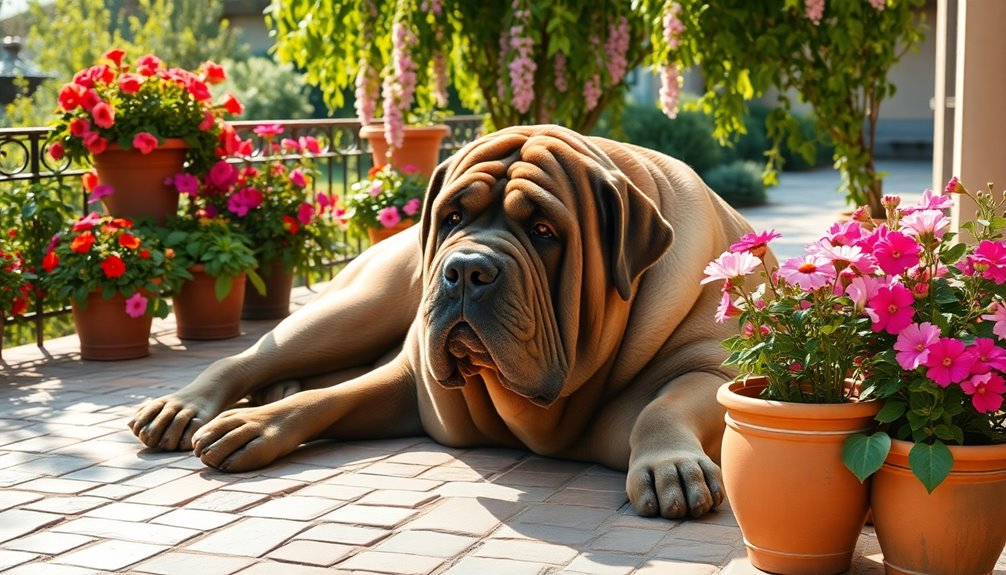
To create the ideal living environment for your Neapolitan Mastiff, you'll need a spacious home with a secure yard for them to roam and play. Keep in mind that they can be sensitive to heat, especially in humid climates, so ensure they've a cool, shaded area to retreat to. Providing the right space and climate conditions is crucial for their overall well-being. Additionally, consider their ample living space needs, as their large size requires room to move freely and comfortably.
Spacious Home With Secure Yard
A spacious home with a secure yard is essential for a Neapolitan Mastiff, as these large dogs thrive when they've room to move and explore.
You'll need enough space indoors for a large orthopedic bed that cushions their joints, and outdoor space where they can roam freely. If you live in an apartment, be prepared for multiple daily walks to ensure your dog gets enough exercise, even if a brief walk suffices. Additionally, it's important to monitor for signs of bloat symptoms, as this breed is particularly susceptible to this serious condition.
A secure, fenced yard is ideal, with a fence at least five or six feet high to keep your Mastiff contained. Avoid underground electronic fences, as they won't hold back a determined dog.
A large yard also helps your pet establish territorial boundaries, which is crucial for their well-being.
While your Neapolitan Mastiff should live indoors with the family, supervision is key. This breed can display territorial behavior, so you'll want to prevent access to areas that could be harmful.
Regular interaction with your family helps prevent aggression and destructive behavior, making a spacious, secure environment vital for their happiness and safety.
Heat Sensitivity in Humid Climates
Neapolitan Mastiffs' heat sensitivity makes it crucial to create an ideal living environment, especially in humid climates. These gentle giants are highly susceptible to overheating, so you'll want to maintain indoor temperatures between 20°C and 30°C. Their short coats don't offer much protection from heat, so always monitor their condition during warm spells. It is important to remember that their poor tolerance for extreme heat can lead to severe health risks if not managed properly.
Ensure your Mastiff has regular access to fresh water and shaded areas to prevent dehydration. Exercise should be moderated in hot conditions; opt for leisurely walks and play sessions during the cooler mornings and evenings. Avoid strenuous activities during peak heat hours to keep your dog comfortable and healthy.
Don't forget to clean their facial wrinkles regularly to prevent moisture buildup, which can lead to skin issues. Gentle bathing with dog-specific shampoo will help keep their skin irritation-free.
Additionally, ensure you check their eyes and ears often to avoid any potential health problems. Keeping a cool resting space is essential for recovery from heat exposure.
Regular veterinary check-ups will help you monitor their overall health, ensuring your Neapolitan Mastiff thrives in a humid climate.
Ancient Roman Battle Companions
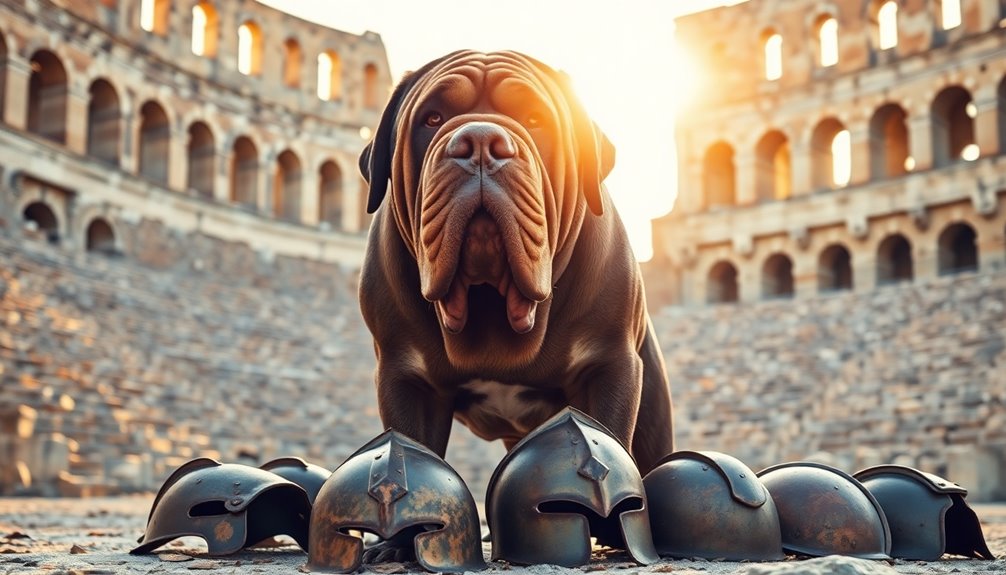
As you explore the role of Neapolitan Mastiffs as ancient guardians of Roman legions, you'll uncover their fierce loyalty and strength in battle. Imagine these powerful dogs, akin to the character Hercules in "The Sandlot", standing alongside soldiers, ready to defend their companions. Their integral part in warfare were significant, showcasing both their intimidating presence and combat skills.
Ancient Guardians of Roman Legions
While the Roman legions marched into battle, they weren't just accompanied by their human soldiers; they'd formidable canine companions as well. The Molossus, an ancestor of the Neapolitan Mastiff, served as a loyal war dog and guardian, while the Cane Corso fought alongside the soldiers and protected their camps. These dogs weren't just pets; they were essential for tracking enemies and disrupting enemy lines. Equipped with spiked collars and specially made armor, these canines faced the chaos of battle head-on. They carried fire baskets filled with flaming oil into enemy ranks, creating chaos and confusion. Moreover, breeds like the Vertragus and Laconian excelled in hunting and tracking, proving vital in guerrilla warfare. The Romans trained these dogs rigorously, emphasizing their practical roles in combat, as their training mirrored the rigorous training regimens of the legionaries themselves. In addition to their combat training, these dogs required regular toilet maintenance to ensure they remained healthy and effective on the battlefield. Despite the often harsh training methods, dogs in Roman culture were viewed with a blend of utility and affection. They symbolized loyalty and fidelity, and their presence on the battlefield provided not just physical support but also a morale boost for the soldiers. The bond between the legions and their canine guardians showcased the deep-rooted connection between man and dog in ancient times.
Hercules in "The Sandlot
Hercules, a symbol of strength and heroism in Roman mythology, may not appear directly in "The Sandlot," but the film echoes themes of perseverance and friendship reminiscent of his legendary labors.
While you won't find Hercules battling monsters or completing epic tasks, the young characters face their own challenges, much like the demigod did in his quests.
In "The Sandlot," each child learns valuable lessons about courage and teamwork. Just as Hercules encountered fears and obstacles, the gang tackles their anxieties, whether it's confronting the terrifying dog, the Beast, or mastering the game of baseball. These colossal statues of heroes often represent the values of loyalty and bravery that the children display as they navigate their adventures. This bond reflects the importance of having a strong support network, similar to how new dads thrive with a support network in their parenting journey.
These moments reflect the spirit of Hercules' trials—patience, determination, and the strength found in friendship.
Moreover, "The Sandlot" captures the essence of growing up, paralleling the timeless narratives surrounding Hercules.
Both stories highlight the importance of bonds formed through shared experiences.
While Hercules may not roam the baseball diamond, the values he embodies—loyalty, bravery, and resilience—resonate deeply within the film's narrative.
Just like Hercules, the characters remind us that the journey of overcoming fears often shapes our greatest adventures.
Large Dog, Large Commitment?
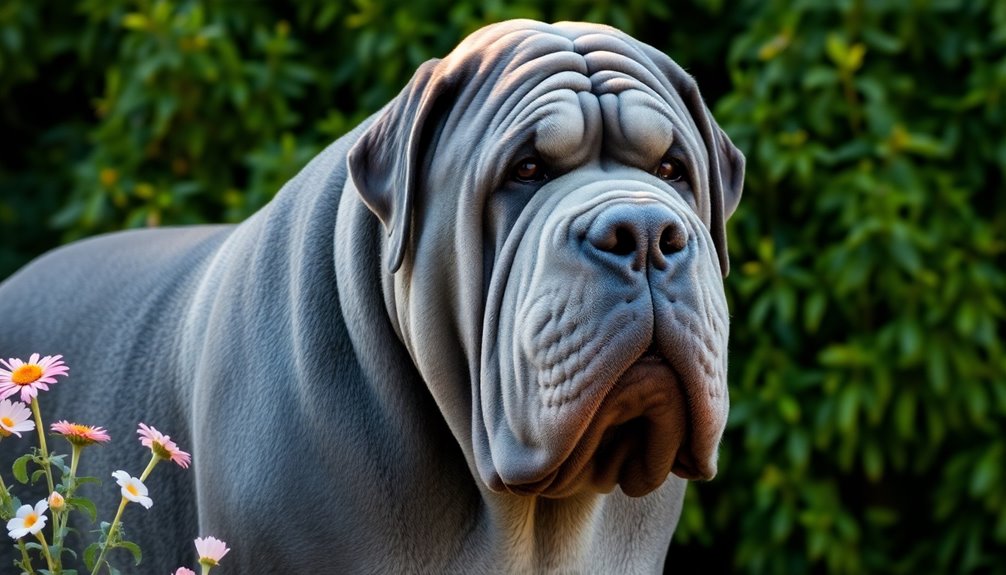
Owning a Neapolitan Mastiff isn't just a choice; it's a commitment that requires your dedication and experience. These large dogs need time-intensive training and socialization to thrive, so be ready to invest effort into their upbringing. Additionally, their strong protective instincts make them exceptional guardians, ensuring your home remains safe. If you're prepared for the responsibility, you'll find a loyal companion who's worth every moment.
Ideal for Experienced Owners
The Neapolitan Mastiff's impressive size and unique temperament make it a breed best suited for experienced dog owners who understand the responsibilities of caring for such a powerful guardian.
You'll need ample space for this giant dog to thrive; large, fenced areas are essential for movement and exercise. Ideally, a home with a spacious yard or patio is crucial to accommodate their size and provide a comfortable environment, especially as they age. Their muscular body requires ample room to move freely and comfortably. Additionally, providing them with a nutrient-rich diet will ensure they maintain their strength and vitality.
Daily exercise is non-negotiable—about 30-45 minutes of moderate activity is essential to keep your Neapolitan healthy. While short walks are important, avoid high-impact activities that could strain their joints. Swimming is an excellent low-impact option to consider as well.
Be prepared for regular veterinary visits to monitor for congenital diseases and joint issues. Consistent access to clean water and attention to grooming, especially their facial wrinkles, can prevent skin problems.
You'll also need to manage drooling with slobber rags. By fully committing to these responsibilities, you'll provide a loving and nurturing environment for your Neapolitan Mastiff, ensuring they flourish as a loyal guardian and cherished companion.
Time-intensive Training Requirements
Training a Neapolitan Mastiff can be a significant commitment due to their size and strength. Starting training early, ideally at eight weeks, is crucial. During this time, your puppy is most receptive to new experiences and socialization.
Expose your Mastiff to various environments, people, and animals to help develop their social skills while reducing behavioral issues. Basic obedience commands like "sit," "stay," and "come" lay the foundation for further training. Additionally, consider utilizing the step-by-step training methods included in specialized resources to enhance your approach.
Given their powerful build, using a sturdy leash and collar is essential to maintain control during sessions. Physical activities should be moderate to avoid exhaustion and joint strain, while regular walks and playtime promote their overall well-being.
Remember, training isn't a one-time event; it's an ongoing process. Regular reinforcement prevents regression, especially during adolescence when continued socialization is vital.
As your Neapolitan Mastiff matures, consider advanced training for specialized roles. Enlisting professional trainers experienced with large breeds can provide valuable insights.
Consistency, positive reinforcement, and patience are key in achieving desired results, ensuring that your majestic companion thrives in any environment.
Frequently Asked Questions
How Much Do Neapolitan Mastiffs Typically Weigh?
Neapolitan Mastiffs typically weigh between 110 and 150 pounds.
Males usually range from 132 to 154 pounds, while females weigh between 110 and 132 pounds.
You'll notice that males tend to be around 40 pounds heavier than females.
Their weight is vital for their powerful build and role as guard dogs.
Keeping an eye on their weight is important for their overall health and longevity, as it can affect their quality of life.
Are Neapolitan Mastiffs Good With Children?
Neapolitan Mastiffs can be great with children if they're raised together from a young age.
They're gentle giants but need supervision during playtime due to their size. It's best to introduce them to older kids, as their strength can lead to accidental injuries.
With early socialization and training, they'll develop a protective nature, ensuring safety around your family.
Just remember to always monitor their interactions to foster a harmonious relationship.
What Dietary Needs Do Neapolitan Mastiffs Have?
Neapolitan Mastiffs require a balanced diet rich in high-quality animal proteins for muscle maintenance and healthy fats for skin and coat health.
You should feed them twice a day, adjusting portions based on their activity level and vet's advice.
Puppies need high-energy diets with joint supplements, while adults and seniors require tailored nutrition to support joint health and manage weight.
Always ensure they've fresh water available and avoid free-feeding to prevent obesity.
Do Neapolitan Mastiffs Shed a Lot?
Yes, Neapolitan Mastiffs shed year-round, but it's generally moderate.
You'll notice increased shedding in spring and fall. To manage this, brush your dog weekly to remove loose hair and distribute skin oils. Using a rubber curry brush or a slicker brush can be effective.
Regular baths every two to three months are sufficient, but make sure to rinse thoroughly to avoid skin irritation. Keeping their skin folds clean is also essential for their overall health.
What Are Common Behavioral Issues in Neapolitan Mastiffs?
Common behavioral issues in Neapolitan Mastiffs often stem from a lack of early socialization, leading to aggression towards strangers and other dogs.
Their stubborn nature can make training challenging, so you'll need consistent, positive reinforcement.
They may also develop separation anxiety and boredom, resulting in destructive behavior if not engaged.
Additionally, they can be prone to excessive barking if not taught the "quiet" command, highlighting the need for strong leadership and regular exercise.
Conclusion
In conclusion, the Neapolitan Mastiff is more than just a majestic guardian; it's a loyal companion with a gentle heart. Their rich history and imposing presence are matched by their loving nature, making them unique. However, owning one requires commitment, training, and a suitable living environment. If you're ready to embrace this noble breed, you'll find a devoted friend who'll protect you fiercely while showering you with affection. Are you prepared for the journey?

